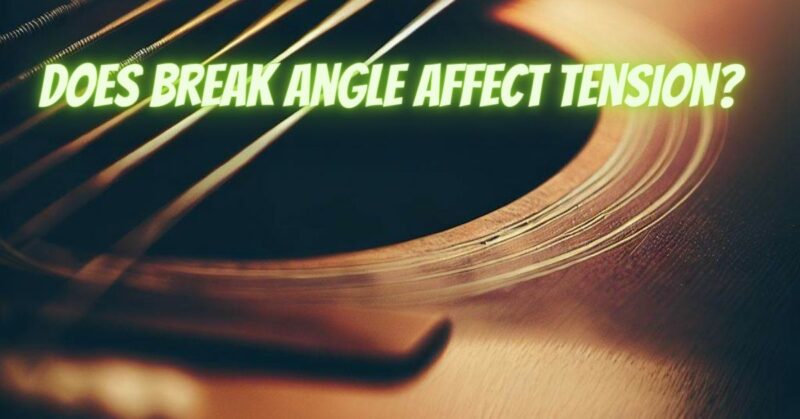The world of stringed instruments is a realm of intricate details, where factors like string tension and break angle significantly impact playability, tone, and overall performance. In this article, we’ll delve into the fascinating interplay between break angle and string tension, exploring how these elements affect one another and their combined influence on your instrument’s playability and sound.
Defining the Break Angle
The break angle, in the context of stringed instruments, refers to the angle at which a string approaches the nut or saddle. It’s crucial to understand that there are two types of break angles:
- Nut Break Angle: This angle is formed as the string passes over the nut before reaching the tuning peg or machine head.
- Saddle Break Angle: The saddle break angle is created as the string transitions from the bridge or tailpiece to the body of the instrument.
How Break Angle Affects Tension
- Increased Tension: A steeper break angle generally leads to increased string tension. This effect is particularly noticeable at the nut, where the angle can be quite sharp. Higher tension can result in a firmer feel under your fingers and contribute to better sustain and clarity. However, excessively high tension can make bending and vibrato techniques more challenging.
- Sustain and Resonance: The break angle’s influence on tension can affect an instrument’s sustain and resonance. When strings have sufficient downward pressure on the nut and saddle, they can transmit vibrations more efficiently, resulting in better sustain and tonal quality.
- String Bending: The break angle’s effect on tension is most noticeable when bending strings. A greater break angle provides more resistance against string bending, making it easier to perform precise bends and control the pitch accurately.
- Buzz and Playability: An excessively shallow break angle, especially at the nut, can reduce string tension, causing buzzing and diminished sustain. It can also lead to intonation issues, making the instrument less playable.
- String Life: The break angle can influence the longevity of your strings. Strings with a consistent and appropriate break angle experience less wear and tear, resulting in a longer lifespan.
Factors Influencing Break Angle and Tension
Several factors influence the break angle and its impact on string tension:
- Nut and Saddle Height: The height of the nut and saddle plays a significant role in determining the break angle. Properly adjusted nut and saddle heights are crucial for achieving the desired tension and playability.
- String Gauge: The thickness or gauge of your strings affects how they respond to changes in break angle. Heavier gauge strings generally require more tension to achieve proper break angles.
- Instrument Design: The design and construction of your instrument, including the headstock angle, bridge type, and tailpiece design (on certain instruments), can affect the break angle and string tension.
Finding the Right Balance
The ideal break angle and string tension depend on your playing style, musical preferences, and instrument setup. It’s essential to strike a balance that suits your needs. Here are some guidelines:
- Nut and Saddle Adjustment: Ensure that the nut and saddle heights are correctly set to achieve an appropriate break angle for your string gauge and playing style.
- String Gauge Selection: Experiment with different string gauges to find the tension that feels most comfortable and produces the desired tone for your instrument.
- Player Preference: Keep in mind that what works for one player may not work for another. Personal preference plays a significant role in determining the ideal break angle and string tension.
The relationship between break angle and string tension is a fundamental aspect of stringed instrument setup and playability. Achieving the right balance between these factors is essential for optimizing your instrument’s tone, playability, and performance. Whether you’re a guitarist, bassist, or any other stringed instrument enthusiast, understanding and experimenting with the break angle and string tension can help you unlock new sonic possibilities and tailor your instrument to your unique musical journey.


